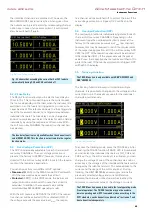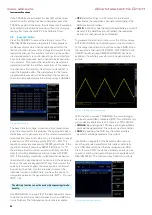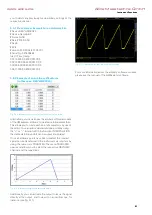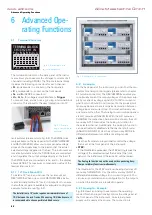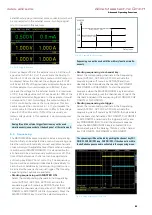
40
Important Notes
40
Important Notes
Any adjustments, replacements of parts, maintenance
and repair may be carried out only by authorized ROHDE
& SCHWARZ technical personnel. Only original parts may
be used for replacing parts relevant to safety (e.g. power
switches, power transformers, fuses). A safety test must al-
ways be performed after parts relevant to safety have been
replaced (visual inspection, PE conductor test, insulation
resistance measurement, leakage current measurement,
functional test). This helps ensure the continued safety of
the product.
1.9 Measurement Categories
This instrument is designed for measurements on circuits
that are only indirectly connected to the low voltage mains
or not connected at all. The instrument is not intended
for measurements within the measurement categories II,
III or IV; the maximum potential against earth generated
by the user must not exceed 250 V
DC
(peak value) in this
application. The following information refers solely to user
safety. Other aspects, such as the maximum voltage, are
described in the technical data and must also be observed.
The measurement categories refer to transients that are
superimposed on the mains voltage. Transients are short,
very fast (steep) current and voltage variations which may
occur periodically and non-periodically. The level of poten-
tial transients increases as the distance to the source of
the low voltage installation decreases.
❙
Measurement CAT IV
: Measurements at the source of
the low voltage installations (e.g. meters)
❙
Measurement CAT III
: Measurements in building
installations (e.g. power distribution installations, power
switches, firmly installed sockets, firmly installed engines
etc.).
❙
Measurement CAT II
: Measurements on circuits
electronically directly connected to the mains (e.g.
household appliances, power tools, etc.)
❙
0
(instruments without measured measurement
category): Other circuits that are not connected directly
to the mains.
1.10 Mains Voltage
The instrument applies 50 Hz / 60 Hz mains voltages rang-
ing from 100 V to 240 V (tolerance ±10%) . Mains voltage
switching is not intended. The input line fuse is accessible
externally. Power socket and fuse holder form a single unit.
You need to first disconnect the power cord from the con-
nector before you can safely replace the fuse (as long as
the fuse holder is undamaged). Next the fuse holder must
be pried out using a screwdriver. The starting point is a
slot next to the contacts. Then the fuse can be forced out
of its mounting and must be replaced by an identical fuse
(please find information about the fuse type below). The
fuse holder will be inserted against the spring pressure un-
til it locks into place. The use of mended fuses or to short
circuit the fuse holder is prohibited. Resulting damage are
not covered by the warranty.
Fuse type
:
T3,15L250V
(size 5 x 20 mm)
1.10 Limits
The R&S®HMC804x is equipped with a protective overload
feature. The protective overload feature prevents dam-
age to the instrument and is intended to protect against
a possible electrical shock. The maximum values for the in-
strument must not be exceeded. The protection limits are
listed on the front panel of the R&S®HMC804x to ensure
the safe operation of the instrument. These protection
limits must be adhered to:
Max. output voltage
32 V
DC
Max. output current
3 A / 5 A / 10 A
(max.100
W)
Max. voltage against earth
250 V
DC
Max. counter-electromotive
33 V
DC
force (CEMF)
Reverse polarity voltage
0.4 V
DC
Max. current for
reverse polarity voltage
3 A
Power supply
100
V
AC
to 240 V
AC
±10%
Frequency
50 Hz / 60 Hz
Max. power consumption
200 W
1.11 Batteries and Rechargeable Batteries/Cells
1. Cells must not be disassembled, opened or crushed.
Fig. 1.2: Back panel R&S®HMC804x with connectors
Fig. 1.3: Connectors on the front panel of the instrument
If the information regarding batteries and rechargeable batter-
ies/cells is not observed either at all or to the extent necessary,
product users may be exposed to the risk of explosions, fire and/
or serious personal injury, and, in some cases, death. Batter-
ies and rechargeable batteries with alkaline electrolytes (e.g.
lithium cells) must be handled in accordance with the EN 62133
standard.
If the instrument is to remain unattended for a longer time period,
it must be switched off at the mains switch for safety reasons.
www.allice.de
Allice Messtechnik GmbH
Summary of Contents for 3593.1006.02
Page 2: ...www allice de Allice Messtechnik GmbH ...
Page 3: ...71 Appendix 71 Appendix www allice de Allice Messtechnik GmbH ...
Page 37: ...35 Anhang 35 Anhang www allice de Allice Messtechnik GmbH ...
Page 39: ...www allice de Allice Messtechnik GmbH ...
Page 40: ...71 Appendix 71 Appendix www allice de Allice Messtechnik GmbH ...
Page 73: ...68 Appendix 68 Appendix www allice de Allice Messtechnik GmbH ...
Page 74: ...69 Appendix 69 Appendix www allice de Allice Messtechnik GmbH ...
Page 75: ...70 Appendix 70 Appendix www allice de Allice Messtechnik GmbH ...
























